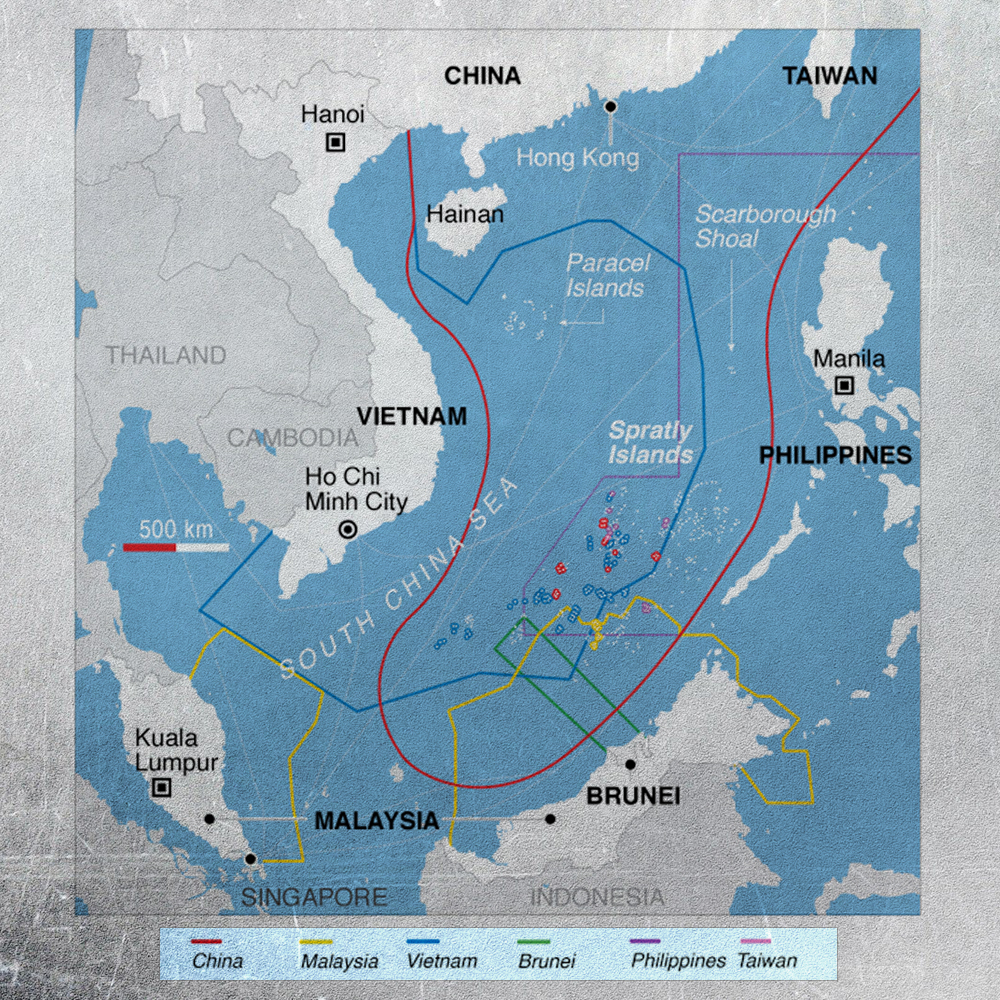Written by Lieutenant Colonel D. Puretsky; Originally appeared at Foreign Military Review #3 2019, translated by AlexD exclusively for SouthFront
The military and political leadership of the People’s Republic of China has been consistently working to improve the combat capabilities of its national Navy, which is able to solve a wide range of tasks both independently and in cooperation with other branches of the Armed Forces. Learning from the experience of the United States, China is actively developing the aircraft carrier component of the fleet. The need to build modern naval forces and, in particular, carrier strike groups (CSG) is based on the geopolitical challenges facing it at the present stage of development and the future.
The creation of China’s CSG began with the reconstruction of the Soviet heavy aircraft carrier (HAC) “Varyag” of Project 1143.5, which was laid down in December 1985 and launched in November 1988 at the Black Sea shipbuilding plant in Nikolaev (the Ukraine). China bought the ship in 2000 and after 16 months of towing, the HAC was delivered to the port of Dalian for modernisation and re-furbishing. In 2012, the aircraft carrier was commissioned into the PLA Navy under the name “Liaoning” (Type 001”). The total cost of the Varyag acquisition was more than $30.5 million, including the lease of a tugboat and payment for sea transit.
In 2015, in Dalian (Liaoning province), China began construction of a second aircraft carrier, named “Shandong” (“Type 001A”), a modified Soviet Project 1143.6. In April 2017, it was launched, and in 2018, it passed the second stage of sea trials.
The transfer of the ship to the fleet should take place this year.
In 2017, the third Chinese multi-purpose aircraft carrier “Type 002” was laid down. It is assumed that its tactical-technical characteristics (TTC) will not be inferior to the characteristics of the American nuclear multipurpose aircraft carrier “Nimitz”. The ship is completely of Chinese design; it will be equipped with a nuclear propulsion system and several electromagnetic catapults. The transfer to the PLA Navy ship is scheduled for 2024.
China is currently implementing a large-scale programme for the construction of aircraft carriers of domestic design and formation of CSGs. So, by 2026, it plans to have three carrier strike groups, and by 2030, at least five, of which up to two CSGs are on combat duty.
Creating a national carrier fleet, the country’s leadership seeks to solve the following tasks:
- the formation of high combat capabilities of the PLA in the event of resolving the Taiwan issue by force;
- increasing the capabilities of the Navy in remote theater operations;
- protection of the state’s maritime interests;
- protecting the merchant fleet and ensuring energy security;
- demonstration of the military industry’s capabilities;
- ideological and psychological impact;
- increasing international influence.
Formation of high combat capabilities of the PLA in the event of resolving the Taiwan issue by force. By deploying carrier strike groups in the East China Sea, the PRC can compete with the US in the regions and minimise Washington’s ability to provide military support to Taipei in the event of a possible military conflict, ensuring a naval blockade of the island. The Chinese Navy considers this scenario in the context of increasing combat capabilities of its Navy, including the CSG.
The Taiwan issue became particularly relevant in September 2018 after the US decision to supply the island with spare parts for airplanes (F-16, C-130 and F-5) in the amount of about 330 million dollars. Washington plans to expand as well military cooperation with Taipei and in the same year adopted the “Taiwan Travel Act”, allowing bilateral exchanges of high-level officials’ delegations. In addition, in October last year, Taipei held an exercise “to repel the Chinese attack”, which worked out issues on the destruction of the landing force. At the same time, American ships passed through the Taiwan Strait, so at the end of October 2018, the Chinese side made a statement “about the growing likelihood of resolving the Taiwan issue by force”.
Taiwan is part of the so-called “first chain” of islands (Japanese Ryukyu Islands, Taiwan and the Philippines, and conventionally “second chain”: Japan, Guam, Indonesia). In the waters located between the Chinese coastline and the “first chain” of islands, Beijing seeks to ensure its own security by preventing the placement of foreign military facilities on them, and the presence of warships and aircraft of foreign states within its borders.
Increasing the capabilities of the PLA Navy in remote theater operations. According to the Chinese Defence Ministry, to turn it into a leading world power, it is necessary to have a modern fleet that can compete with any fleet in the world in various aspects, including aircraft carriers.
In this matter, the PRC relies on the experience of the United States, which uses the Navy to “project power” in order to strengthen its influence in regions of interest to them.
The formation of aircraft carrier strike groups is carried out in parallel with China’s establishment of its foreign military bases. The first is the PLA logistics hub in Djibouti (Obok), which is also part of the Chinese strategy “Threads of Pearls”, which involves the establishment of a military naval base network along the Indian Ocean coasts.
In addition, the presence of an aircraft carrier fleet significantly enhances the PLA’s ability to protect and defend China’s exclusive maritime economic zone. The CSG will ensure stronger control over disputed areas in the East China Sea (Senkaku archipelago, claimed by Japan, China and Taiwan), in the South China Sea (Parasel Islands, China, Vietnam and Taiwan) and Spratly Islands (China, Vietnam, Malaysia, Philippines, Brunei and Taiwan).
Protection of the state’s maritime interests. The country’s military and political leadership pays special attention to this issue. It is assumed that by 2050, the Chinese “maritime economy” (or “gross ocean product”) will reach 30% of the country’ GDP due to increased production of marine resources (fishing), as well as hydrocarbons. China’s main interests are concentrated in the Pacific Ocean and the East and South China Seas (due to the availability of marine resources and hydrocarbon production on the sea shelves). However, as the “Sea Silk Road of the 21st Century” develops and China’s interest in the Russian Northern Sea Route grows, its “maritime interests” will expand to include new regions, including the Indian and Arctic Oceans.
Protecting the merchant fleet and ensuring energy security. About 90% of China’s trade turnover and raw material supplies are carried out by sea transport. The country has the fourth largest merchant fleet in the world and the third largest shipbuilding capacity for 2018. In addition, of the ten largest ports in the world, five are owned by China.
In this regard, the security of trade and hydrocarbon supply routes is a priority for Beijing. The protection of merchant ships travelling from the Middle East (due to the ongoing threat of piracy in the Gulf of Aden) along the so-called 21st Century Silk Road, as well as from Latin America, remains relevant.
Demonstration of the military industry’s capabilities. China has successfully carried out modernisation and re-furbishing of the HAC “Varyag”, equipped it with modern navigation equipment, weapons, “Jian-15” aircraft of domestic production. In the future, the Navy command plans to implement the experience of combined basing on aircraft carriers, both airplanes and helicopters.
Ideological and psychological impact. In recent years, the country’s military and political leadership has actively promoted the idea of “reviving the great nation of China”.
A special role in this process is played by President Xi Jinping’s principle of “realising the great Chinese dream”. The Chinese leadership is actively engaged in ideological work to disseminate among the population the idea of “the coming of the historical moment” of gaining world domination and becoming a leading world power.
At the same time, the development of the aircraft carrier fleet is one of the most important factors increasing national pride and patriotism and positively influencing the image of the Communist Party of China.
Increasing international influence. The PRC seeks to strengthen its position in the international community and compete with the United States in international affairs through a comprehensive resolution of economic, political and military tasks. Building aircraft carriers is one of the effective means of increasing China’s influence at sea, “projecting power” and demonstrating military might. Currently, the Pentagon can form ten CSG, which are capable of solving problems in different regions of the world. However, China’s possession of even one aircraft carrier poses a threat to the United States in the Asia-Pacific region and gives Beijing grounds for consistent resolution of territorial disputes in the East and South China Seas, as well as for extending its influence to other regions of the world.
China’s military and political leadership is implementing a large-scale programme of aircraft carrier strike groups, which it regards as an important tool in addressing a wide range of military, political and geostrategic tasks.
These include the PCR’s efforts to establish parity with the US in the Pacific to resolve the Taiwanese issue by force, protect and defend its exclusive maritime zone and economic interests in the Pacific, if necessary. In addition, Beijing seeks to ensure its energy security and commercial vessel protection in remote regions of the world, which is only possible with a modern navy and aircraft carrier fleet. At the same time, China’s leadership is enhancing the country’s international prestige and influence.









